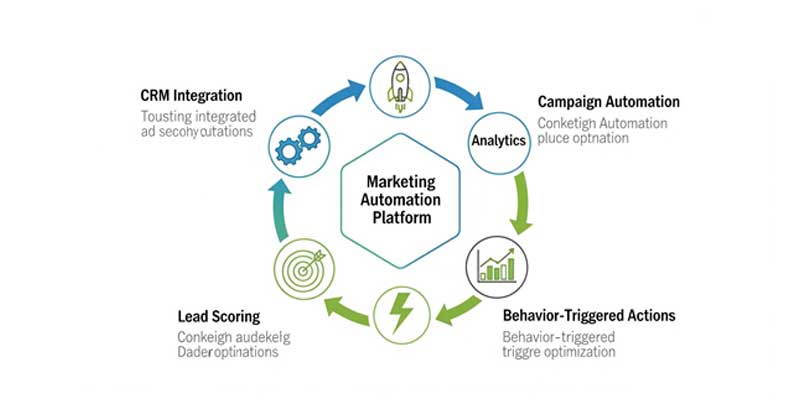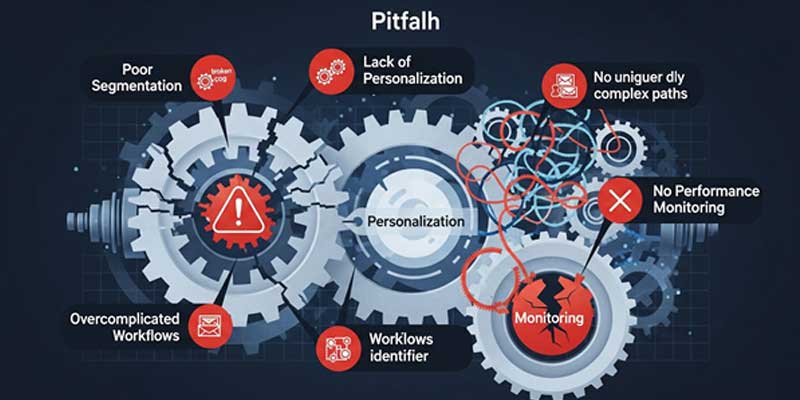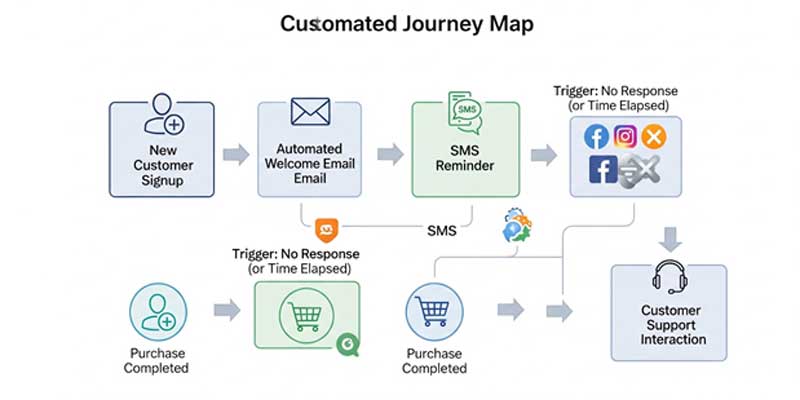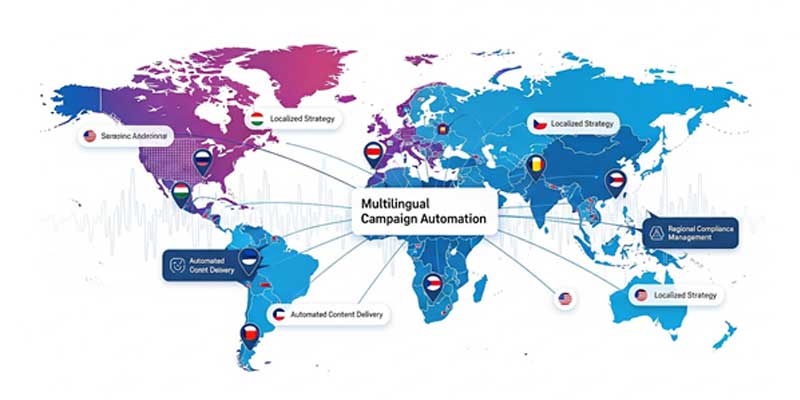

In the modern world characterized by faster and faster information processing, marketing automation tools are becoming more popular to increase ROI. Knowledge of how to apply marketing automation strategies for ROI can be a real game changer and the determinant for the growth of a business as opposed to stagnation and loss to competitors. As the best PPC agency in Chennai, we have discussed five great ideas to improve your ROI in automation by adopting the right marketing automation techniques. ROI, or Return on Investment, is a key measure of success in digital marketing, showing how much revenue is generated compared to marketing costs. It helps businesses understand which strategies work best—whether paid ads, content marketing, SEO, or email campaigns. Unlike traditional marketing, digital channels provide precise data, allowing easy tracking of costs and results. Beyond direct sales, ROI includes metrics like customer engagement and brand awareness, which contribute to long-term growth. Marketing automation plays a vital role in improving ROI by reducing manual tasks, targeting the right audience, and optimizing campaigns based on performance data. Focusing on ROI ensures smarter budget allocation, better decision-making, and sustained profitability.
Marketing automation refers to the use of software platforms and technologies to automate repetitive marketing tasks and workflows. Instead of manually managing every customer interaction, businesses can set up automated processes that handle tasks like email campaigns, lead scoring, customer segmentation, and follow-ups. This helps save time, reduce human error, and ensure consistent communication across various channels. The goal is to deliver the right message to the right audience at the right time, improving efficiency and effectiveness.

Marketing automation is built on several essential components that work together to simplify and optimize marketing efforts:
These components work in sync to streamline complex marketing tasks and improve decision-making based on real-time data.
Marketing automation plays a crucial role in smoothing the customer journey by delivering personalized, relevant content at each stage. From the moment a visitor lands on your website to the point of purchase and beyond, automation ensures that every touchpoint is connected and meaningful.
For example, when a visitor downloads an eBook, an automated workflow can send follow-up emails with related offers or product recommendations. Similarly, abandoned cart emails are triggered automatically if a customer doesn’t complete a purchase, gently encouraging them to return. By reducing manual effort, eliminating delays, and tailoring interactions to individual needs, automation improves customer experience, boosts engagement, and increases conversion rates.
Of all the marketing automation approaches, the most profitable in terms of ROI is the usage of an elaborate lead-scoring model. Marketing automation tools allow organizations to dynamically assign values to potential customers depending on how they engage with your firm. This subtle strategy starts with defining complex behavioral monitoring parameters within your Marketing Automation System. When you lay down scoring models based on WEB visits, emails, and downloading of white papers and the like, you have a sound model for evaluating leads. The leads are then subsequently followed up by the system in predefined custom workflows based on score criteria. When lead scoring is done using marketing automation, the organizations have been able to get up to 77% higher ROI than using traditional techniques. This significant improvement in the ROI in automation proves the reasonability of the automated lead management system.
The advancement of technology has made it easier for marketing automation to change the business world on the side of personalization. Bygone are the days when marketing communications could use a single message for a section of an audience and expect results. Any marketing automation strategy for ROI in today’s world has to encompass complex personalization methods that enable tailored experiences for the individual client. Personal Dynamic content insertion which involves the system to place content regarding the customers based on the behavior of the user, automated email personality, and smart content recommendations of the customer helps in generating interesting customer experiences. Actually, these tools identify different patterns in the customers’ behavior and take action to change the delivered content to correspond or reflect the customers’ interests. The effect is straightforward – benchmarks suggest that tailored marketing automation initiatives have the potential to elevate the ROI of automation by as much as 122 percent to non-personalized strategies.
Today’s consumer journey is multi-channel and for a business to be successful, it has to be everywhere where the customer is, and marketing automation tools do just that brilliantly. The link between all kinds of groups such as email blasts, social media feeds, and Website syndication also helps in managing the overall content with a fairly low level of manual intervention. Marketing automation tools at the latest levels generate integrated consumer profiles that monitor customer exchange in various platforms, thus enhancing its accuracy. The marketing real strength of having multiple channels is the ability to provide a consistent customer experience while at the same time providing granularity and ability to attribute outcomes to the channel. Such overall concepts for marketing automation strategies for ROI usually mean an increase in revenues of 25% more compared with the single-channel strategies, stressing the heuristic utility of the integrated concepts of the marketing automation solutions.
The use of advanced AI in marketing automation tools has paved the way for greater possibilities of ROI improvement. Now there are even such advanced features as predictive lead scoring that measure not only the standard measuring points, customer churn prediction that again helps to keep the most valuable clients, and automated content optimization that changes if necessary to increase engagement. All of these capabilities powered by AI are profound advancements in the marketing automation strategies for ROI. Smart send-time optimization means your messages reach audiences at the best time possible, and purchase pattern analysis is used to predict the behavior of audiences in future purchases. That is why those organizations that use AI technology for marketing automation for return on investment have recorded up to 41% greater conversion rates proving the vast role of artificial intelligence in the effectiveness of marketing.
Sustaining improvement is the key to achieving positive ROI in automation current marketing automation vendors offer various and strong testing features that determine your ROI. From a marketing perspective, this means that businesses are always able to iteratively hone their approach through systematic A/B testing of email content, landing pages, calls to action, etc.
Most of the current marketing automation tools allow for detailed customer journey mapping and tend to enhance each and every customer interaction. The systematic way of testing and optimization is quite effective and amazing, as this is proven through research as companies who test their marketing automation strategies for ROI yield an average of 28 percent enhancement in conversion rates.
The effect of the MA should be viewed not only in terms of campaign results but in terms of revenue as well. The advanced system in marketing automation offers ways to track WWW visits, email engagements, landing page conversions, and social media interactions. These tools also assist firms in controlling other significant value measures including the cost of acquiring customers, the value of the customers, and even the ROI by channel. When these metrics are followed keenly, various firms can always tweak their marketing automation for ROI and thus, optimize the returns on investment in automation.

One of the biggest mistakes in marketing automation is poor audience segmentation. Treating all customers the same results in generic messages that fail to engage specific groups. Effective segmentation divides the audience based on behavior, demographics, purchase history, or engagement level, allowing for highly targeted campaigns. Without clear segmentation, automated campaigns lose relevance, reducing click-through rates, conversions, and ultimately ROI.
Generic, one-size-fits-all messages are ineffective in today’s marketing landscape. Ignoring personalization limits the value of automation. Personalization tailors content based on user preferences, past behavior, or interactions, making messages more relevant. Well-personalized campaigns boost engagement, foster customer loyalty, and significantly improve conversion rates, which directly impacts ROI.
Complex workflows with too many steps or unnecessary automation rules often backfire. They can confuse the system, create redundancies, or result in incorrect message timing. Simple, well-thought-out workflows focused on clear objectives perform best. Streamlining automation ensures efficiency, minimizes errors, and improves the user experience while driving higher ROI.
Many businesses set up automation once and forget to monitor its performance. Without regular analysis, poorly performing workflows go unchecked, leading to wasted resources. Continuous monitoring allows for timely adjustments, optimization of underperforming campaigns, and data-driven improvements, all of which are essential to maximizing ROI.
Automation enables businesses to deliver dynamic content and personalized product recommendations to thousands of customers at once. By analyzing user behavior, automated systems serve highly relevant content or product suggestions, improving user experience and increasing the likelihood of purchase, which drives ROI.
Automated lead scoring helps prioritize high-potential leads by assigning scores based on engagement metrics. Automated nurturing workflows send timely, targeted content to guide prospects through the sales funnel. This strategy focuses resources on leads most likely to convert, improving efficiency and ROI.

Integrating automation across multiple channels ensures a consistent and timely customer journey. Email campaigns can be paired with SMS reminders or social media posts triggered by user behavior. Multi-channel automation broadens reach, increases engagement, and ensures no touchpoint is missed, boosting overall ROI.
AI enhances automation by predicting customer behavior and automatically adjusting campaigns. Predictive analytics identify which leads are most likely to convert, what content performs best, and when to engage customers. This smart decision-making reduces waste, improves targeting, and drives higher returns.
Real-time triggers respond instantly to user actions, such as website visits, cart abandonment, or content downloads. For example, a customer abandoning a cart receives an automated email reminder within minutes. These timely interventions are more effective than scheduled messages, improving conversion rates and ROI.
Paid advertising provides instant traffic and measurable results, while organic strategies, like SEO and content marketing, build long-term visibility. Automation enhances both by streamlining ad campaigns and scheduling organic content publication. Paid campaigns focus on quick wins, whereas organic builds sustainable growth.
Content marketing drives engagement, builds trust, and educates prospects. Automation supports this by scheduling blog posts, promoting articles on social media, and delivering content based on user behavior. Automated content workflows nurture leads over time, improving ROI by keeping audiences engaged without constant manual effort.
While SEO focuses on organic search rankings, automation enhances it by scheduling regular content updates, automating metadata generation, and monitoring performance. Automated alerts for broken links or slow pages help maintain technical SEO health, improving rankings and organic traffic in the long run.
Automation tools schedule posts, track engagement, and respond to customer interactions across social media platforms. This keeps brands active and responsive without dedicating excessive time, helping build an engaged audience, increase brand awareness, and drive ROI through consistent visibility.
Important KPIs include conversion rate, cost per lead, customer acquisition cost, email open rate, click-through rate, and customer lifetime value. These metrics help businesses gauge the effectiveness of automation strategies and identify areas for improvement.
ROI = (Revenue from Automated Campaigns – Automation Costs) ÷ Automation Costs × 100. This formula provides a clear percentage reflecting the effectiveness of automation efforts, helping marketers justify budgets and optimize campaigns based on performance data.
Successful companies report improvements such as a 30% increase in lead conversions, a 25% reduction in marketing spend, or a 50% boost in customer engagement through automation. These case studies show that well-implemented automation delivers measurable, sustainable ROI.

Automating translations and content delivery in multiple languages helps global businesses communicate with diverse audiences efficiently. Automation platforms manage regional content variations without manual effort, improving reach and ROI.
Automation helps manage GDPR, CCPA, and other regional compliance requirements by automatically handling consent tracking, data privacy requests, and regional data storage rules, ensuring legal safety and customer trust.
Automation enables effective global segmentation by analyzing location data, purchase behavior, and language preferences. This ensures campaigns are relevant to local markets, increasing engagement and conversions worldwide.
AI-driven automation dynamically adapts based on data and behavior, while rule-based automation follows preset logic. AI offers greater flexibility, delivering smarter, more personalized interactions that boost ROI in complex environments.
Using machine learning, predictive lead scoring evaluates the likelihood of a lead converting based on historical data, helping marketers focus on high-value prospects and improve resource allocation.
Chatbots offer instant, automated customer support and product recommendations, guiding users through the purchase process and improving engagement and conversion rates without additional human resources.
With rising data privacy concerns, automation platforms now focus on user consent management, data minimization, and transparent tracking practices. These ensure trust and compliance while maintaining effective automation.